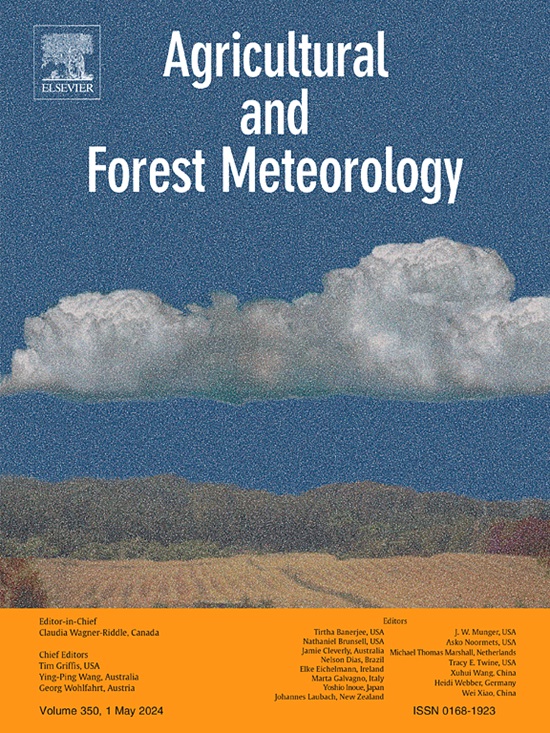超越气象数据:用ERA5-Land模拟树木生长
IF 5.6
1区 农林科学
Q1 AGRONOMY
引用次数: 0
摘要
森林越来越多地受到气候变化的影响,影响树木生长和碳封存。与树木生长密切相关的树木年轮宽度是一个关键的气候指标,但描述年轮宽度或生长的模型往往缺乏全面的环境数据。本研究评估了ERA5-Land数据与自动气象站观测数据的树轮宽度预测,强调了扩展和全球气候数据的价值。我们分析了723个站点平均和趋势的树木年轮年表,这些年轮年表来自欧洲两种阔叶植物和两种裸子植物,并将它们与era5陆地气候数据、二氧化碳浓度和干旱指数(SPEI12)相结合。其中一个子集与气象站数据进行了比较。为了模拟树木年轮宽度的年际变化,我们使用线性模型来评估参数的重要性。era5 -基于陆地和气象站的模式表现相似,保持稳定的相关性和一致的误差。基于气象站气象数据的模式强调SPEI12、日照时数和极端温度,而ERA5-Land模式强调SPEI12、露点温度(湿度)和总降水量。CO2正影响裸子植物的生长。ERA5-Land促进了更广泛的空间分析,并纳入了蒸发、积雪和土壤湿度等额外因素。每月的评估揭示了每个物种参数的重要性。我们的研究结果证实,ERA5-Land是模拟树木生长的可靠替代方法,为气候-植被相互作用提供了新的见解。未充分利用的参数,如空气湿度、土壤湿度和温度以及径流,可以将它们纳入未来的增长模型。因此,使用ERA5-Land可以加深我们对全球范围内森林对各种环境驱动因素的反应的理解。本文章由计算机程序翻译,如有差异,请以英文原文为准。
Beyond meteorological data: Modelling tree growth with ERA5-Land
Forests are increasingly impacted by climate change, affecting tree growth and carbon sequestration. Tree-ring width, closely related to tree growth, is a key climate proxy, yet models describing ring width or growth often lack comprehensive environmental data. This study assesses ERA5-Land data for tree-ring width prediction compared to automatic weather station observations, emphasizing the value of extended and global climate data.
We analyzed 723 site-averaged and detrended tree-ring chronologies from two broadleaved and two gymnosperm species across Europe, integrating them with ERA5-Land climate data, CO2 concentration, and a drought index (SPEI12). A subset was compared with weather station data. For modelling interannual variations of tree-ring width we used linear models to assess parameter importance.
ERA5-Land and weather-station-based models performed similarly, maintaining stable correlations and consistent errors. Models based on meteorological data from weather stations highlighted SPEI12, sunshine duration, and temperature extremes, while ERA5-Land models emphasized SPEI12, dew-point temperature (humidity), and total precipitation. CO2 positively influenced the growth of gymnosperm species. ERA5-Land facilitated broader spatial analysis and incorporated additional factors like evaporation, snow cover, and soil moisture. Monthly assessments revealed the importance of parameters for each species.
Our findings confirm that ERA5-Land is a reliable alternative for modeling tree growth, offering new insights into climate-vegetation interactions. The ready availability of underutilized parameters, such as air humidity, soil moisture and temperature, and runoff, enables their inclusion in future growth models. Using ERA5-Land can therefore deepen our understanding of forest responses to diverse environmental drivers on a global scale.
求助全文
通过发布文献求助,成功后即可免费获取论文全文。
去求助
来源期刊
CiteScore
10.30
自引率
9.70%
发文量
415
审稿时长
69 days
期刊介绍:
Agricultural and Forest Meteorology is an international journal for the publication of original articles and reviews on the inter-relationship between meteorology, agriculture, forestry, and natural ecosystems. Emphasis is on basic and applied scientific research relevant to practical problems in the field of plant and soil sciences, ecology and biogeochemistry as affected by weather as well as climate variability and change. Theoretical models should be tested against experimental data. Articles must appeal to an international audience. Special issues devoted to single topics are also published.
Typical topics include canopy micrometeorology (e.g. canopy radiation transfer, turbulence near the ground, evapotranspiration, energy balance, fluxes of trace gases), micrometeorological instrumentation (e.g., sensors for trace gases, flux measurement instruments, radiation measurement techniques), aerobiology (e.g. the dispersion of pollen, spores, insects and pesticides), biometeorology (e.g. the effect of weather and climate on plant distribution, crop yield, water-use efficiency, and plant phenology), forest-fire/weather interactions, and feedbacks from vegetation to weather and the climate system.

 求助内容:
求助内容: 应助结果提醒方式:
应助结果提醒方式:


